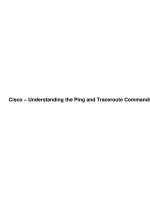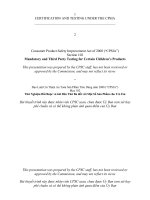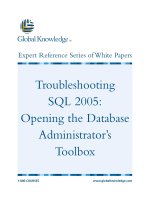Tài liệu Troubleshooting a NIC Using the Ping Command doc
Bạn đang xem bản rút gọn của tài liệu. Xem và tải ngay bản đầy đủ của tài liệu tại đây (11.96 KB, 3 trang )
1 - 3 IT Essentials I v2.0 - Lab 9.7.2 Copyright 2002, Cisco Systems, Inc.
Lab 9.7.2: Troubleshooting a NIC Using the Ping Command
Estimated time: 15 Minutes
Objective
Upon completion of this lab, the student will be able to use the Ping command to test
connectivity and troubleshoot problems based on Ping command results.
Equipment
The following equipment is required for this exercise:
• Several Windows 98 or earlier PC’s with networking installed and configured
• One hub or switch
• One PC with Internet access
Scenario
A PC technician often receives calls from users with complaints about the network. One
morning a user calls and complains that they are unable to reach anything on the
network. Because the user is in an office in another building, it is decided to try
troubleshooting the problem remotely before visiting their office.
Procedures
When working with computers that have networking installed, technicians will be asked to
troubleshoot a variety of problems. Depending on the size of the company, this can
become quite challenging. If the users are spread out across multiple floors, buildings, or
even cities, it can become extremely time consuming to visit every office for every
problem. Luckily, there are utilities that allow a technician to begin troubleshooting a
problem without leaving the office.
There are a wide variety of troubleshooting tools available to a technician. Many of these
tools can be expensive to purchase. However, there are a few utilities that are free and
come with almost every operating system. One of the most commonly used utilities is the
Packet Internet Groper (Ping) command. The Ping command is used to test connectivity
between two hosts (PC’s). When a device is pinged, a signal is being sent to the device,
which will then reply back. If the ping is successful, then the connection between the two
devices is good. If the ping fails, then there is a problem between the devices.
Step 1
Open a command prompt as described below.
Click on Start > Run
Type the word “command” and click OK
Type the command ping a.b.c.d (where a.b.c.d is the IP address of the NIC.)
Was a reply received?
_______________________________
2 - 3 IT Essentials I v2.0 - Lab 9.7.2 Copyright 2002, Cisco Systems, Inc.
How many times did the NIC reply back?
___________________________________
How many bytes were used?
____________________________________________
How much time did it take to receive a reply?
________________________________
What was the maximum Time To Live (TTL)?
________________________________
Step 2
A workstation’s own NIC may be pinged by using its IP address, or something called the
loopback address. The address 127.0.0.1 is reserved as the loopback address and is not
used on the Internet. Instead, the loopback is an address that pings the NIC installed in
the workstation you are currently using.
Type the command ping 127.0.0.1.
Did you receive a reply back?
Are the values for bytes, time, and TTL the same as last time? If not, what has changed?
__________________________________________________________________
Step 3
If the technician can successfully ping the PC address, and the loopback, then the NIC
and TCP/IP have been successfully installed. Now it is time to test whether or not the
other hosts within the network can be reached.
Type “ping A.B.C.D” (This time A.B.C.D is the address of another workstation within
the network.)
Was a reply received a reply back? If not, what was the error message?
__________________________________________________________________
__________________________________________________________________
Are the values the same for bytes, time, and TTL, as they were in Step 1? If not, what
has changed?
__________________________________________________________________
__________________________________________________________________
Step 4
If the technician is able to successfully ping another workstation that means there is a
good connection between the two machines. However, there are times when using the
ping command will result in a problem.
3 - 3 IT Essentials I v2.0 - Lab 9.7.2 Copyright 2002, Cisco Systems, Inc.
Type the command “ping A.B.C.D.” (“A.B.C.D” is an IP address for a workstation
outside of the network.)
What message was received?
__________________________________________________________________
__________________________________________________________________
What might this message mean?
__________________________________________________________________
__________________________________________________________________
Now using a PC with an Internet connection, open a DOS prompt and type ping
1.1.1.1
What message was received this time?
__________________________________________________________________
__________________________________________________________________
What might this message mean?
__________________________________________________________________
__________________________________________________________________
Troubleshooting
If there is trouble pinging the IP address of the workstation, or if the technician is unable
to ping the loopback address, then theTCP/IP settings need to be checked. If the TCP/IP
was not set properly, then the ping function will not work. Check to make sure that the
protocol is correctly installed and bound to the NIC.
If there is trouble pinging other hosts within the network, then check the cable and make
sure that it is correctly plugged into the hub or switch. Check the IP address and the
subnet mask to make sure they have been entered correctly.
Reflection
Once a PC is installed on a network, much of a technician’s time will be spent
troubleshooting network problems. It is important that a technician try to save as much
time as possible. Ping is a great utility to begin troubleshooting a problem. Ping will help a
technician determine whether the network problem is related to a bad cable, an incorrect
TCP/IP setting, or a problem with a remote device. Make sure to be comfortable using
the Ping command and its responses.









